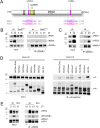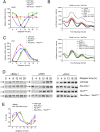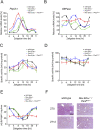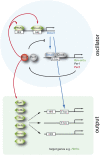The mammalian clock component PERIOD2 coordinates circadian output by interaction with nuclear receptors
- PMID: 20159955
- PMCID: PMC2816734
- DOI: 10.1101/gad.564110
The mammalian clock component PERIOD2 coordinates circadian output by interaction with nuclear receptors
Abstract
Mammalian circadian clocks provide a temporal framework to synchronize biological functions. To obtain robust rhythms with a periodicity of about a day, these clocks use molecular oscillators consisting of two interlocked feedback loops. The core loop generates rhythms by transcriptional repression via the Period (PER) and Cryptochrome (CRY) proteins, whereas the stabilizing loop establishes roughly antiphasic rhythms via nuclear receptors. Nuclear receptors also govern many pathways that affect metabolism and physiology. Here we show that the core loop component PER2 can coordinate circadian output with the circadian oscillator. PER2 interacts with nuclear receptors including PPARalpha and REV-ERBalpha and serves as a coregulator of nuclear receptor-mediated transcription. Consequently, PER2 is rhythmically bound at the promoters of nuclear receptor target genes in vivo. In this way, the circadian oscillator can modulate the expression of nuclear receptor target genes like Bmal1, Hnf1alpha, and Glucose-6-phosphatase. The concept that PER2 may propagate clock information to metabolic pathways via nuclear receptors adds an important facet to the clock-dependent regulation of biological networks.
Figures







Comment in
-
A wheel of time: the circadian clock, nuclear receptors, and physiology.Genes Dev. 2010 Apr 15;24(8):741-7. doi: 10.1101/gad.1920710. Genes Dev. 2010. PMID: 20395363 Free PMC article.
Similar articles
-
Redundant function of REV-ERBalpha and beta and non-essential role for Bmal1 cycling in transcriptional regulation of intracellular circadian rhythms.PLoS Genet. 2008 Feb 29;4(2):e1000023. doi: 10.1371/journal.pgen.1000023. PLoS Genet. 2008. PMID: 18454201 Free PMC article.
-
The orphan nuclear receptor REV-ERBalpha controls circadian transcription within the positive limb of the mammalian circadian oscillator.Cell. 2002 Jul 26;110(2):251-60. doi: 10.1016/s0092-8674(02)00825-5. Cell. 2002. PMID: 12150932
-
Regulation of circadian behaviour and metabolism by REV-ERB-α and REV-ERB-β.Nature. 2012 Mar 29;485(7396):123-7. doi: 10.1038/nature11048. Nature. 2012. PMID: 22460952 Free PMC article.
-
Melatonin feedback on clock genes: a theory involving the proteasome.J Pineal Res. 2015 Jan;58(1):1-11. doi: 10.1111/jpi.12189. Epub 2014 Nov 22. J Pineal Res. 2015. PMID: 25369242 Review.
-
[The roles of clock genes in obesity].Nihon Rinsho. 2013 Feb;71(2):244-8. Nihon Rinsho. 2013. PMID: 23631200 Review. Japanese.
Cited by
-
Epigenetic events influencing the biological clock: Panacea for neurodegeneration.Heliyon. 2024 Oct 2;10(19):e38836. doi: 10.1016/j.heliyon.2024.e38836. eCollection 2024 Oct 15. Heliyon. 2024. PMID: 39430507 Free PMC article. Review.
-
The circadian clock in enamel development.Int J Oral Sci. 2024 Sep 6;16(1):56. doi: 10.1038/s41368-024-00317-9. Int J Oral Sci. 2024. PMID: 39242565 Free PMC article. Review.
-
The contribution of circadian clock to the biological processes.Front Mol Biosci. 2024 Jun 6;11:1387576. doi: 10.3389/fmolb.2024.1387576. eCollection 2024. Front Mol Biosci. 2024. PMID: 38903177 Free PMC article. Review.
-
Chrono-tailored drug delivery systems: recent advances and future directions.Drug Deliv Transl Res. 2024 Jul;14(7):1756-1775. doi: 10.1007/s13346-024-01539-4. Epub 2024 Feb 28. Drug Deliv Transl Res. 2024. PMID: 38416386 Free PMC article. Review.
-
Phosphatidic acid signaling and function in nuclei.Prog Lipid Res. 2024 Jan;93:101267. doi: 10.1016/j.plipres.2023.101267. Epub 2023 Dec 26. Prog Lipid Res. 2024. PMID: 38154743 Review.
References
-
- Albrecht U, Sun ZS, Eichele G, Lee CC. A differential response of two putative mammalian circadian regulators, mper1 and mper2, to light. Cell. 1997;91:1055–1064. - PubMed
-
- Albrecht U, Bordon A, Schmutz I, Ripperger J. The multiple facets of Per2. Cold Spring Harb Symp Quant Biol. 2007;72:95–104. - PubMed
-
- Asher G, Gatfield D, Stratmann M, Reinke H, Dibner C, Kreppel F, Mostoslavsky R, Alt FW, Schibler U. SIRT1 regulates circadian clock gene expression through PER2 deacetylation. Cell. 2008;134:317–328. - PubMed
-
- Bae K, Jin X, Maywood ES, Hastings MH, Reppert SM, Weaver DR. Differential functions of mPer1, mPer2, and mPer3 in the SCN circadian clock. Neuron. 2001;30:525–536. - PubMed
-
- Balsalobre A, Brown SA, Marcacci L, Tronche F, Kellendonk C, Reichardt HM, Schutz G, Schibler U. Resetting of circadian time in peripheral tissues by glucocorticoid signaling. Science. 2000;289:2344–2347. - PubMed
Publication types
MeSH terms
Substances
LinkOut - more resources
Full Text Sources
Other Literature Sources
Molecular Biology Databases
